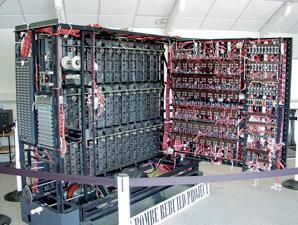
5 minute read
The life and times of Alan Turing
from 2012-12 Sydney (2)
by Indian Link
chess. He was awarded a FRS in 1951.
Who knows what lies beneath the rise of our civilisation?
Of the tears, sweat and suffering hidden below its surface. Of social ill-treatment due to misunderstanding and misinterpretation suffered by many a scientist. Yet the actions of these geniuses have made our lives more comfortable.
Today our world comprises of computers, mobile phones, tablets, Facebook and Twitter. It seems that the world cannot survive for even a minute without computers. But who dreamt of inventing a computer? The answer is Alan Turing, whose centenary the world celebrates in 2012. His dream has given us the luxury and convenience of a computer. This tribute lauds the genius of Turing and his life.
Alan Turing was the founder of Computer Science, significantly influenced computing, computer science, artificial intelligence, developmental biology and the mathematical theory of computability. He also made important contributions to codebreaking during World War II.
Alan Mathison Turing was born on June 23, 1912 in London as the second son to his parents. His father worked for the Indian Civil Service in Chatrapur in Orissa and his mother was the daughter of the chief engineer of Madras Railways in Chennai. His brilliance became apparent as soon as he was admitted to school, recognised by the headmistress and other teachers. At 13, he joined the Sherborne School in Dorset and mathematics and science, especially experiments in chemistry, were his favourite subjects much to the annoyance of his teachers who emphasised on the classics.
Contrary to expectations, Turing studied advanced mathematics and even digested Einstein’s theories while at school, extrapolating the physicist’s interpretation of Newton’s laws. But he was a loner, and had none with whom he could discuss and share his ideas. His paper on Einstein’s theory was shown only to his mother. Later, Turing made a friend in Christopher Marcom, whose life was unfortunately cut short because of tuberculosis. This had a profound impact on
Turing who became an atheist. He began feeling that all phenomena including the working of the brain, must be materialistic. This paved the way for his future theories in Artificial Intelligence, Cryptanalysis and computers.
After school, Turing entered the prestigious Cambridge University as an undergraduate at Kings College. At 22, he obtained a first class honours in Mathematics and was elected to be a Fellow on the strength of his thesis on ‘Central Limit Theorem’. Turing also worked on the Entscheidungsproblem (Decision Problem) formulated by the great German mathematician Hilbert. Turing showed that any effectively calculable function can be calculated by a ‘Universal Turing Machine’, a type of an abstract computer. These are studied even today in Theory of Computation.
Cryptology or code breaking was another passion of Turing which he pursued while he worked for a PhD in Mathematics at the Institute of Advanced Study in Princeton, as he built stages of an electro-mechanical binary multiplier.
Turing is well known for his work in breaking the German code during the war. He started working for the Government Code and Cipher School (GCCS) at Bletchley Park in Britain. During 1939-40
Turing and others designed a code-breaker called ‘Bombe’ that supplied intelligence to Britain for the rest of the war. They decoded about 39,000 messages a month, which later rose to 84,000. From the mass of German signals which were in a state of a mess, Bombe worked out millions of possibilities till it arrived at a meaningful result. Turing was awarded the OBE for this significant contribution.

However, a secret aspect of his personality took a heavy toll. Turing was a homosexual at a time when being gay was considered a crime. He was offered a choice – to spend his life in jail or be treated with female hormones. He opted for the latter and underwent the chemical castration via injections of stilboestrol for a year, as a result of which he became impotent and developed gynecomastia. In addition, his security clearance was removed and with it went his cryptanalysis practice for the government.
He also wrote two papers on this topic which were so valuable and vital that GCCS did not release them to the public for nearly seventy years.
From 1945-47 Turing worked at the National Physical Laboratory in London where he formulated a Stored Program Computer and later wrote a paper on Intelligent Machinery, published after his death. His design for ACE (Automatic Computing Engine) was a complete specification for a general purpose digital computer. Had NPL followed his advice, a computer with increased memory would have resulted long before it really came to light. Some of the early British and American computers were built based on this design. Turing later became the Deputy Director (there was no director) of the Computing Laboratory at the University of Manchester. Here he developed software for his computer and designed Ferranti Mark I, the world’s first available electronic digital computer.
Turing is the father of modern Cognitive Science and believed that the human brain is largely a digital computer. He tackled the problem of Artificial Intelligence and proposed a test to qualify a machine to be called intelligent. This Turing Test is current even today. Turing had felt that it was better to build a machine with a child’s mind and educate it, rather than build it like an adult. Then he wrote a programme that played
In 1953, Turing was made a reader in Theory of Computing and he worked on Artificial Life, a chemical basis of Morphogenesis concentrating on pattern and form in living organisms. He used his Ferranti Mark I to model chemical mechanisms by which genes could control development of anatomical structure in plant and animals. This work is also considered seminal in that field.
Turing was found dead on June 8, 1954 with suicide believed to be the cause of his death, however some have challenged this conclusion, stating that his death was accidental. Eccentricity thy name is genius, and Turing is no exception. On the first day of the school term at Sherborne, a determined Turning rode his bike 97kms to school as a general strike had resulted in no public transport. On another occasion he ran to London, a distance of 64 kilometres to attend a high level meeting. He was a world class marathon runner. He usually suffered from hay fever in June, so Turing would ride his bike wearing a gas mask. The chain on his bicycle would come off at regular intervals, but instead of fixing the problem, Turing counted the number of times the pedal went round and at the proper count he would get off the bike and put the chain back in position. Another of his strange habits was to chain his coffee mug to the radiator pipe to prevent it from being stolen!
No wonder Turing is now seen as one of the most influential men of our times. The Turing Award, almost like a Nobel Prize, is given to outstanding work in the field of computing and he has been acknowledged in various ways. In 2009, the British Government rendered its apology for the inhuman treatment he was accorded.

Turing’s life was that of genius, drama and tragedy, but to recall line from T S Eliot: Suffering is action; out of suffering comes poetry.
Contrary to expectations, Turing studied advanced mathematics and even digested Einstein’s theories while at school, extrapolating the physicist’s interpretation of Newton’s laws
In 1953, Turing was made a reader in Theory of Computing and he worked on Artificial Life, a chemical basis of Morphogenesis concentrating on pattern and form in living organisms












